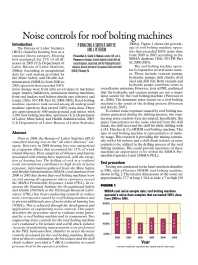Mining Publication: Noise Controls For Roof Bolting Machines
Original creation date: January 2009
Prior to 2004, the Bureau of Labor Statistics (BLS) classified hearing loss in the "all other illnesses" category. However, in 2004 hearing loss was categorized as a separate illness that accounted for 11% of work related illnesses. Most categories of illnesses and injuries associated with mining have improved, with the exception of hearing loss. The drilling of rock in a confined work environment contributes to high levels of noise exposure. Information gathered from the Mine Safety and Health Administration (MSHA) coal database from 2000 to 2005 has shown that roof bolting machines were second among all equipment whose operators exceed the MSHA Permissible Exposure Limit (PEL). In response, the National Institute for Occupational Safety and Health (NIOSH) at the Pittsburgh Research Laboratory (PRL) has been conducting research to reduce noise overexposure caused by roof bolting machines and to prevent additional cases of noise-induced hearing loss (NIHL). This is achieved through the development and application of engineering noise controls. This paper describes the procedure used to evaluate noise generated by a roof bolting machine and its components. Two engineering noise controls for the roof bolting machine were evaluated: a bit isolator and a drill chuck isolator. Acoustic beamforming measurements were performed at the PRL hemi-anechoic chamber to assess the noise controls developed for the roof bolting machine. Results showed that in combination, the bit isolator and the drill chuck isolator provided a 7 dB(A) reduction in sound pressure level at the operator position.
Authors: PG Kovalchik, AK Smith, RJ Matetic, JS Peterson
See Also
- Determination of Sound Exposures (DOSES): Software Manual and Implementation Guide
- Less Sound Underground: Reducing Roof Bolting Machine Drilling Noise
- Modified Tail Section Reduces Noise on a Continuous Mining Machine
- Noise Abatement of Pneumatic Rock Drill
- A Noise Control for A Roof Bolting Machine: Collapsible Drill Steel Enclosure
- Results of Noise Measurements from Underground Testing of a Roof Bolting Machine Duty Cycle
- Sound Power Level Study of a Roof Bolter
- Technology News 536 - NIOSH Develops New Software to Analyze and Reduce Noise Exposure
- Technology News 538: Acoustic Enclosure to Reduce Noise From Vibrating Screen Mechanism Housings
- Water Well Safety Bits: Health And Safety Information For The Water Well Industry
- Content source: National Institute for Occupational Safety and Health, Mining Program


 ShareCompartir
ShareCompartir
